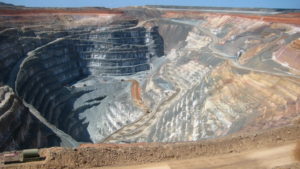Remote Borehole Sensors

Challenge
Newcrest Mining faces a significant challenge in measuring temperature and pressure beneath an open pit where rock temperature is extremely high and saturated steam may be present. To address this challenge, we are developing a wireless underground sensor system capable of measuring temperature and pressure in geothermal regions.
While traditional wired sensors and data loggers can be used for site measurements, they have two key drawbacks. Underground cables can break, and above-ground data loggers at the hole collar are vulnerable to damage during bench blasts and vehicle activity. Our wireless sensor system offers significant advantages, including the elimination of underground sensor cables, which eliminates breakage issues. Additionally, surface receiver equipment can be placed in damage-safe locations away from the hole collar.
However, designing a wireless underground sensor system poses several technical challenges, including designing a sensor/transmitter that can function at high pressures and temperatures of up to 150°C, transmitting data wirelessly over distances of 100m to 200m through solid and fractured rock, and ensuring that the system receivers are sensitive enough to process low-level underground sensor signals while remaining robust against site magnetic noise sources.
This wireless sensing system is the first of its kind globally, and its underground data transmission capabilities can be extended to other mining applications where gathering data from long ranges in rocky environments is crucial. By solving the challenges of wireless data transmission in geothermal environments, we can help revolutionize mining operations and contribute to more efficient and effective mining practices.
Research
Mining3 has been at the forefront of using extremely low-frequency magnetic signals for underground ranging measurements and data transmissions in the mining environment. This project builds upon our prior research by introducing solid-state, extremely low-frequency transmitter technology that has no moving parts.
In addition to developing this new transmission technology, we are also conducting research on signal reception, which involves processing low-level magnetic signals in the presence of high-level environmental noise. To achieve this, we are developing a design architecture that can operate at extremely high geothermal temperatures.
Our goal is to create a highly reliable system that can transmit underground data wirelessly over comparatively long ranges in challenging mining environments, including areas with high temperatures and solid and fractured rock. By utilizing solid-state technology, we can improve the durability and reliability of our transmission systems, while also reducing maintenance needs and costs.
This research has the potential to revolutionize data transmission and through ground communication in the mining industry, improving safety and efficiency, reducing costs, and enhancing the overall effectiveness of mining operations.
Benefits
Wireless underground sensors offer numerous advantages over traditional wired sensors, including the elimination of underground sensor cables, which eliminates cable breakage issues. In addition, surface receiver equipment can be located at safe distances from the hole collar, as there are no sensor wires to worry about.
One of the main benefits of using wireless underground sensors is that solar-powered wireless surface receiver equipment is easy to relocate on site, as there are no sensor cables or power supply cables to re-route or protect from vehicles. This also leads to improved system maintenance since there are no sensors or power cables that are exposed to surface damage hazards.
The wireless nature of the system also allows for easy integration with the mine’s LAN system, and the option to remotely access measurement data without the need for physical site access. This makes it easier for engineers and mining personnel to monitor data in real time and respond to issues quickly, even when they are not physically present at the mine site.
Overall, the use of wireless underground sensors in mining operations can significantly improve safety, efficiency, and data accuracy while reducing costs associated with maintenance and repairs of wired systems. The ability to integrate with existing LAN systems and remotely access measurement data is an added benefit that can help mining companies make informed decisions and optimize their operations for greater productivity and profitability.
Status
The second phase of our research project is dedicated to the development and testing of prototype units for use at Newcrest’s Lihir Gold Mine. To this end, the surface elements of the system are currently being shipped to the mine site for installation and initial testing.
The focus of this phase is on the underground pressure and temperature sensors, which are being designed to withstand the extreme conditions of the mining environment. The sensors are expected to be shipped to Lihir shortly, where they will undergo comprehensive testing and validation to ensure they meet the required specifications.
Once installed, the prototype units will undergo rigorous testing to validate their performance and reliability. This testing will help identify any potential issues and provide valuable feedback to refine the design and improve the functionality of the system.
The ultimate goal of this research project is to develop a wireless underground sensing system that can operate reliably in challenging mining environments, such as those found at the Lihir Gold Mine. If successful, this technology has the potential to revolutionize mining operations, improving safety, reducing costs, and enhancing the efficiency and effectiveness of mining processes.










